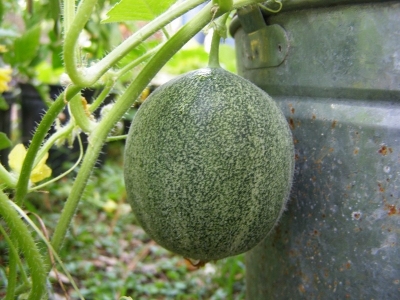15 Gardening Tips for Growing Melons

Melons are some of the most popular fruits grown on the vine in the U.S. Many backyard gardens feature melons as a favorite late summer and early fall harvest treat. Interestingly, melons are in the same plant family as pumpkins, cucumbers and squash.
Although they won’t cross-pollinate, they are compatible with these familiar plants in terms of soil and water requirements. Here are 15 ways you can increase your yields and melon sizes.
TIP 1: KNOW YOUR MELONS AND WHAT THEY WANT.
There are a lot of melons available out there, but the most common in North America are watermelon, cantaloupe, and honeydew (in that order). Most watermelons are of the standard sweet variety (or a hybrid of the same) in either giant or standard size (12 lb or less). Most cantaloupes are either Ambrosia or French Orange Charentais. Ambrosia is the common type you’ll see in stores weighing about 4 pounds at around six inches in diameter while French’s are about 1/3 the size and round instead of oblong. The differences between the melon types will determine their growth factor and required nutrients. Generally, the larger the melon, the longer the growing season.
TIP 2: START YOUR MELON SEEDLINGS INDOORS.
Most melons require 65 degree or higher soil temperatures to germinate, but the optimum is 70-90 degrees. So indoor germination of seeds is a must in most of the U.S. You’ll get bigger (earlier) starter plants and they’ll likely be healthier.
TIP 3: TRANSPLANT MELONS WHEN READY, NOT BEFORE.
When you transplant your melons, the outside temperature at night should be averaging 50 degrees or close to it. The plants should have at least two rather large leaves and should be hardened.
TIP 4: REMOVABLE ROW COVERS ARE USEFUL FOR MELONS.
Using removable row covers allows you to cover the melon plants at night in the early season to keep them warmer. This speeds plant growth.
TIP 5: USE SOIL HEATING METHODS TO INCREASE MELON SIZE AND YIELDS.
The number one factor in great melon production from plants is soil temperature. If the average soil temperature in the morning (7-9am) is 70 degrees or better, master gardener studies have shown that melon yields will be 20-30% higher. Black plastic sheeting over the soil around the melon plants to keep the soil warm works best.
TIP 6: KEEP THE SOIL PERFECT.
Your soil should drain well and have plenty of nutrients in it. Most melons prefer a pH of 6.0-6.5.
TIP 7: CULTIVATE SOIL VERY LIGHTLY OR NOT AT ALL.
Melon roots are fairly high in the soil, so cultivating should be done with extreme care so as not to damage those roots.
TIP 8: WATER MELONS HEAVILY AND INFREQUENTLY.
Melons prefer flood-style watering rather than intermittent watering more often. Water at 1-2 inches weekly with a source that’s close to the ground (drip, soaker, low-lying flood). Use mulches or the above-mentioned plastic sheeting to help retain soil moisture.
TIP 9: KNOW WHEN POLLINATION IS READY AND MAKE IT HAPPEN.
Without proper pollination, melons will not grow. Be sure to have encouraged bees or other pollinators to be in the area at the right time or hand pollinate yourself. Every melon type has a different need and timing for this, so know your melons (#1 above).
TIP 10: WEED MELONS WELL.
Keep the weeds and competing plants at bay.
TIP 11: CONTROL THE MELON PLANT’S ENERGY USAGE.
Assuming fertilization is done right, most melon plants will attempt to produce 2-3 melons per vine. A good gardener will pinch off melon buds that are too close together and keep the number per vine low so the plants will pour all of its energy into fewer melons, producing larger fruits.
TIP 12: BED THE GROWING MELONS.
As the melons gain size, “bed” them by couching mulch around and under the melons to keep them dry and off the soil. This encourages round, beautiful melons and discourages unsightly soil “spots” and spoilage.
TIP 13: HARVEST MELONS WHEN READY, NOT BEFORE.
Each melon is different in its maturation time and indicators. Separate the melons from the vine yourself, as if you wait for them to do so naturally, they will already be rotting inside. Each melon will ripen on its own, so one plant may produce harvests for two or three weeks.
TIP 14: UNDERSTAND “SLIP” AND WHY BACKYARD MELONS ARE BETTER.
“Slip” refers to the time the melon has reached full ripeness (sugar production) and is ready for harvest. Commercial melons are usually harvested 1/2 to 3/4 slip (early), which means they do not produce as much sweet sugar as do home grown.
TIP 15: ENJOY THEM WITH FRIENDS.
Keeping your melons all to yourself is not just selfish, but it’s no fun. Have family and friends over to enjoy them with you and share the harvest!
Có thể bạn quan tâm
Phần mềm

Phối trộn thức ăn chăn nuôi

Pha dung dịch thủy canh

Định mức cho tôm ăn

Phối trộn phân bón NPK

Xác định tỷ lệ tôm sống

Chuyển đổi đơn vị phân bón

Xác định công suất sục khí

Chuyển đổi đơn vị tôm

Tính diện tích nhà kính

Tính thể tích ao hồ



 How to Grow Great Green Geans In Containers
How to Grow Great Green Geans In Containers  Create a Working Garden Plan
Create a Working Garden Plan